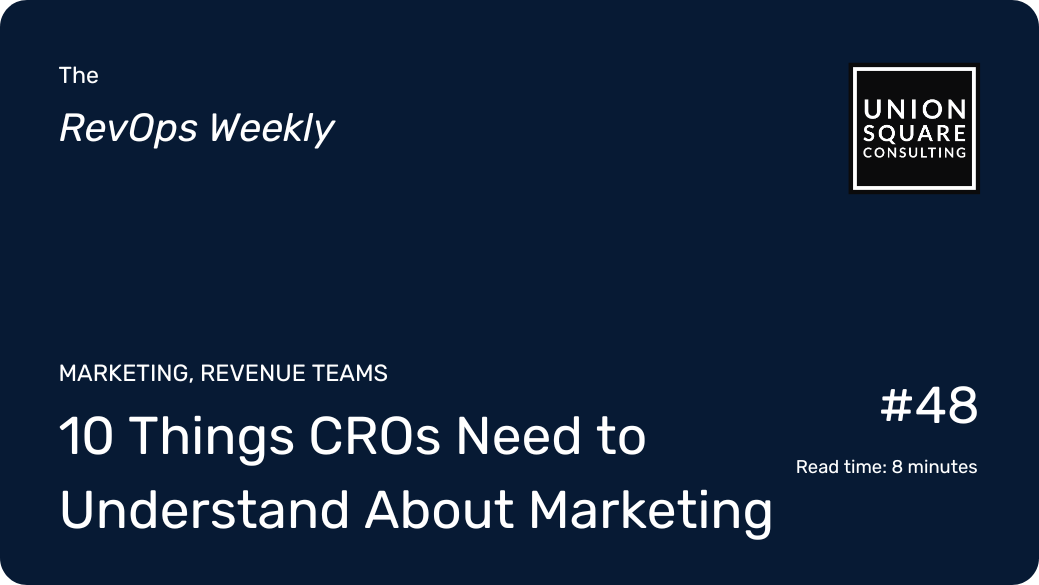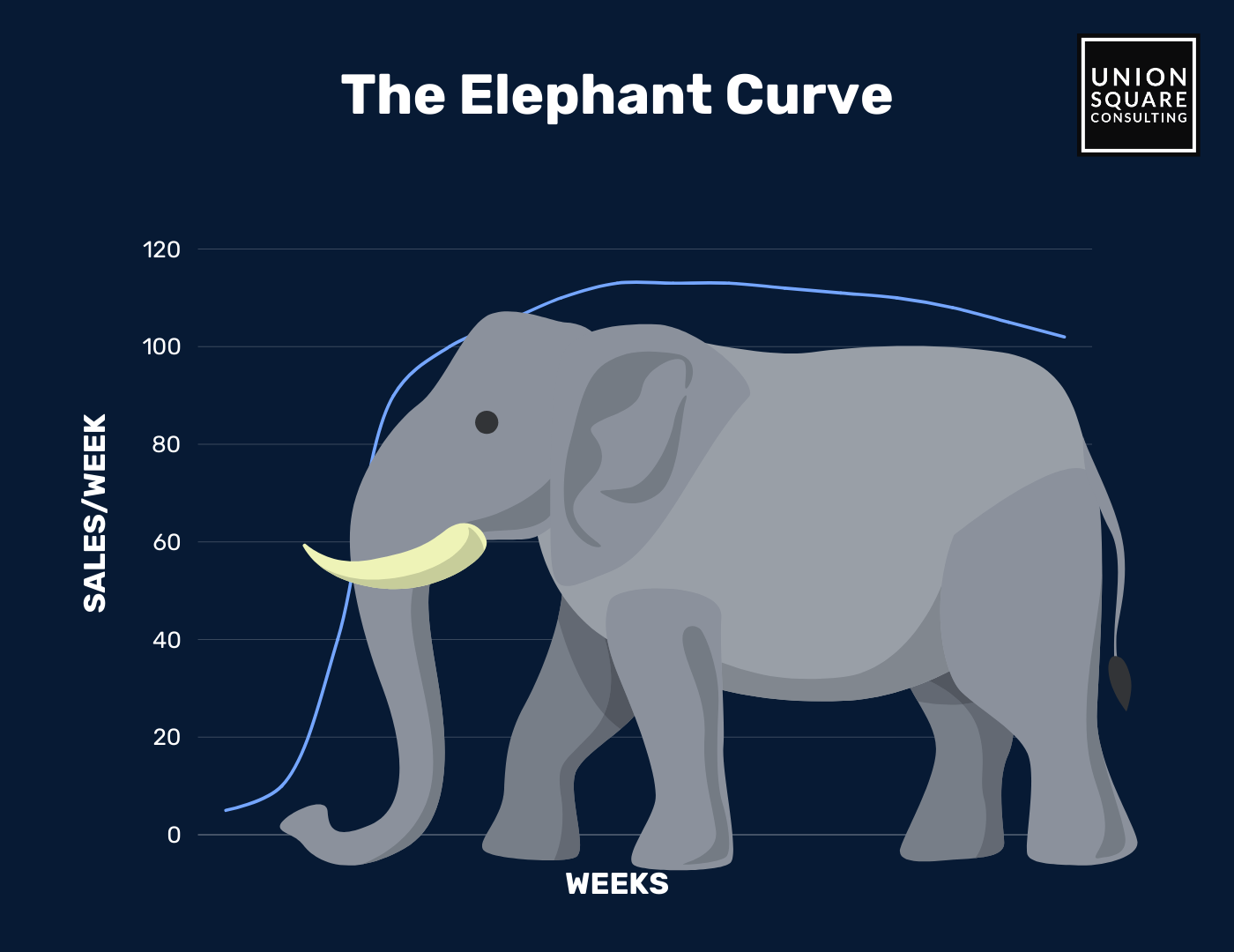
10 Things CROs Need to Understand About Marketing
Read time: 8 minutesExec Summary
- It’s common for RevOps and marketing to have a culture barrier
- Marketing wants CROs to know:
- Results don’t happen overnight
- We crave your feedback
- We feel little control over hitting revenue targets
- Don’t disregard brand
- Put the contact role on the opp (or else!)
- Learn the Elephant Curve
- Help us with MQL definitions
- Sales is the best amplifier for marketing
- We want on the pipeline council
- Marketers can become CROs too
These days, more and more companies are having their marketing departments report to the CRO. A few factors may be influencing this:
1. It can be cost-inefficient to have both a CRO and a CMO
2. One chief means more alignment between go-to-market teams
3. Some companies want to centralize ALL revenue teams under the CRO
Whether you’re for or against this growing trend, one thing remains clear: Marketing and RevOps are deeply interconnected. As a Strategic RevOps consultant who grew up in Marketing Operations, I’ve experienced first-hand how these departments impact each other (for better or worse).
But not every CRO or RevOps professional comes from a marketing background. This can lead to several disconnects and points of friction between the two departments, like two cultures coming together who don’t know each other’s customs.
Whether you’re a CRO that finds yourself at the marketing helm, or you just want to be a better partner to your marketing team/leader, here are 10 things marketers want you to understand.
1. Results Don’t Happen Overnight (Usually)
Building momentum in the market requires long term investments in sustained campaigns.
Most of the time we launch a campaign with a tiny hope it will “go viral”. But there’s no guaranteed recipe for virality – and even virality isn’t a guarantee that a campaign will be a success.
(Just look at Solo Stove’s campaign with Snoop Dogg, which amassed over 19.5 Billion overall impressions but actually cost them more money than they made.)
It can be hard to wait patiently for momentum, but that’s the name of the game.
It’s really important to not give up on a campaign or program in the first week if you aren’t seeing the results you want.
2. We Crave Your Feedback
Marketers need all kinds of feedback. How are the leads performing? Which partners are crushing it? How often are prospects telling you they found us on Linkedin?
Input like this helps to give marketing better ideas and clearer direction for future campaigns.
Valuable feedback explains WHY something isn’t working. Underperforming channel? Bad budget allocation? Wrong ICP?
As a CRO/RevOps person, your specialty lies in slicing and dicing the data to build a story of what’s happening based on the insights you learn. This puts you in the best position to give marketing the kind of feedback that makes an impact. RevOps needs to support both sales and marketing with picklists and processes to close the loop on quality feedback.
3. We Feel Little Control Over Hitting Revenue Targets
Marketing gets a bad reputation for measuring things that don’t matter. We look at clicks instead of deals… We look at MQLs instead of revenue… In fact, in yesterday’s RevOps Corner Podcast episode with Renee Cohen, we talked about just how bad the MQL situation has gotten for B2B SaaS.
Because marketers aren’t out there closing.
Whether or not sales makes something out of our precious MQLs feels entirely out of our control. Everyone wants to focus on metrics they can directly influence.
The best balance for this is to ensure that our marketing GOALS are rooted in pipeline generation and New ARR, but give plenty of opportunity to track KPIs that we have direct control over, too.
Here’s the difference: Our goal is what we’re shooting for – maybe what our bonus is based on. The KPI is going to tell us if we’re doing the right things to hit those goals. Monitoring KPI’s frequently makes us more likely to hit our goals.
4. Brand Drives Demand
Tim Kopp has famously said for years, “brand drives demand”. Period. Every sales rep has experienced the comforting sigh that comes right after a prospect says, “Acme! oh yes, I have heard of you guys – I see you everywhere”!
Brand recognition is priceless. Hard to track? Yes. But without a doubt, brand is essential.
As a RevOps professional, you can be a better partner to marketing by looking for creative ways to measure the ROI on demand generation. One way to do this is to see how brand campaigns correlate with volume of inbound (such as SEO or direct traffic).
At minimum, try not to de-prioritize or dismiss brand projects – even if there isn’t a direct ROI.
5. Put the Contact Role on the Opportunity (Or Else)
We know you’re selling – but who are you selling to?
Go the extra step and take a couple of minutes to put the correct contact role on the opportunity. This gives marketing so much information about how the opportunity was sourced and where we should keep investing.
Pro Tip: Tell your revenue operations team that you only want reps to be able to create an opportunity FROM the contact page. This fixes this pesky issue most of the time.
Bonus Pro Tip: This is also vital for Customer Success. Who is the main user? Who is the billing contact? Don’t make people chase this info. Just put the contact role on that original opportunity.
6. As a CRO, You Need to Learn The Elephant Curve
Remember what we said about momentum? It’s really important.
The concept of the elephant curve explains that most campaigns and programs experience some quick growth, but then level off. We have to keep “stacking” campaigns on each other to maintain the “near exponential” growth curve that we want.
This usually comes down to budget. We can’t front-load the whole budget with 2 events and then sit back for the rest of the quarter. Marketing is all about momentum.

7. Our MQL Definitions Probably Need Work
The way we define an MQL can make or break sales and marketing alignment.
The worst possible scenario is that marketing celebrates a high volume of MQLs – and sales cringes. CRO’s need to know how crucial the alignment is on qualification criteria. Many times the disconnect on this topic is swept under the rug – but that makes it worse.
We fix this by creating thoughtful qualification criteria and evaluating them often, including input from sales.
When sales believes in the MQL definition, they WILL follow up. This is the best way to be certain your marketing dollars will never be wasted.
8. Sales is the Best Amplifier for Marketing
Simply sharing marketing content with your network and your contacts in the pipeline is a fantastic way to build the brand. The most successful reps pay attention to what’s coming out of marketing and will use this as a tool, or a “reason to reach out”.
CROs should prescribe this behavior to their teams in order to get more out of our marketing efforts.
9. We Want to Be Part of a Pipeline Council
A pipeline council is a cross-functional executive committee that meets regularly to discuss the health of the pipeline and actively find solutions to issues. If you don’t yet have a pipeline council set up, you should!
It’s crucial for sales and marketing to both be a part of strategic meetings like these. We’re at our best when we get to hear feedback and learn what the sales team is up against in the market.
Pipeline council meetings go deeper than the typical sales-marketing update. They don’t pull punches, they don’t gloss over issues, and they don’t leave any part of the go-to-market engine out. These gatherings are about taking action, not just reviewing numbers.
10. Marketers Want to Be CROs Too
Many marketers out there have taken the leap to CRO. One of my dear friends Rebecca Grimes is a great example of a rockstar CMO turned CRO!
Marketers are creative, passionate, operationally driven, and . These traits are essential for a CRO … so keep in mind that your marketing leaders may end up as great candidates to delve into sales and grow from there.

When you’re ready, here’s how we can help:
Get a Free 1:1 Revenue Efficiency Workshop
Get one of our Senior Revenue Strategists to yourself for 1 hour and leave with a plan to increase the money-making power of your go-to-market operations.
Hire Us!
Bring us on as your Strategic RevOps Team and realize the growth potential of your revenue engine. There are 3 ways to work with us.
Get more tips like these, sent right to your inbox.
Subscribe for fresh, relevant revenue growth tips delivered every week.
